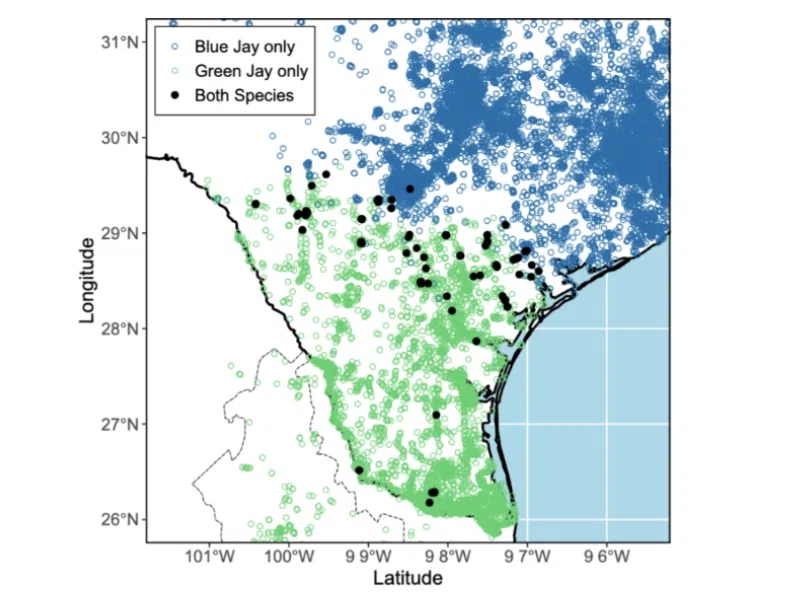‘Grue jay’? Blue jay meets green jay, and a hybrid marvel emerges
Sign up now: Get ST's newsletters delivered to your inbox

The “grue jay” had the blue feathers of a blue jay and the spot over its eye that makes a green jay.
PHOTO: BRIAN STOKES/UNIVERSITY OF TEXAS
Follow topic:
What do you get when you cross a blue jay with a green jay?
Spoiler alert: Not a blue-green jay.
What you get instead is a bird that looks improvised: the blue jay’s crisp tail feathers, the green jay’s emerald mask, and a grab bag of vocalisations that swing between the familiar jeer of a blue jay and the clicks and rattles of its tropical cousin.
A bird, in other words, that seems unlikely.
Hybridisation itself is not shocking. Ducks, for example, are prolific blenders.
But jays are different. They are corvids, among the cleverest birds alive, known for their loyalty to their mates and their knack for recognising a neighbour, even a human one, after years.
The explanation, of course, is climate change, plus a dash of suburban sprawl
“We think it’s the first observed vertebrate that’s hybridised as a result of two species both expanding their ranges due, at least in part, to climate change,” said Mr Brian Stokes, a doctoral student of biology at the University of Texas at Austin.
He is the first author of the study published on Sept 10 in the journal Ecology and Evolution and reported on by CNN.
In recent decades, green jays have been inching north from Mexico and South Texas, while blue jays, ubiquitous across the eastern US, have been sidling west.
Backyard feeders, warmer nights, and a general human rearranging of the landscape brought them together.
For the first time in memory, their ranges overlap in the scrub and subdivisions outside San Antonio, Texas.
Researchers have confirmed the lineage after trapping one bird and drawing blood from it.
The bird had blue feathers on its back and tail and white spots on its wings, similar to a blue jay. But it lacked a blue jay’s spiky crown and had a spot over its eye that is one telltale sign of a green jay.
Some bird spotters have started calling it a “grue jay”.
The outlier followed a flock of blue jays and made similar calls. But it also produced the clicks and rattling vocalisations of a green jay.
Blue jays and green jays last shared a common ancestor some seven million years ago.
A hybrid was documented in the 1960s, but under captive conditions. That bird sits in a museum drawer in Texas, frozen in time.

The ranges of blue jays and green jays have overlapped as a result of climate change and suburban sprawl, researchers have discovered.
PHOTO: BRIAN STOKES/UNIVERSITY OF TEXAS
This one, alive and banded, continues to haunt local backyards.
Professor Gavin Leighton, who teaches biology at Buffalo State University in Western New York who has researched trends in hybridisation among wild birds, described it as “a biological curveball”.
“Both of these jay species form long-term social bonds with a mate,” he told CNN. “We would expect them to be pretty choosy about who they form these pair bonds with.”
Perhaps, Prof Leighton speculated, it was the end of breeding season and the birds were under pressure.
“If they aren’t having good luck finding an individual in their own species that is also without a mate, then maybe there’s a higher risk of making a mistake,” he said.
Whether more hybrids appear is an open question. For now, the bird remains an anomaly, half of one world, half of another.
So what do you get when you cross a blue jay with a green jay?
It may be that the future is improvised, uneasy, and already perched on the fence outside your window.


